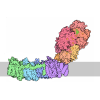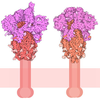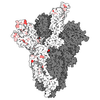+ Open data
Open data
- Basic information
Basic information
| Entry | Database: PDB / ID: 8yka | |||||||||||||||||||||||||||||||||||||||
|---|---|---|---|---|---|---|---|---|---|---|---|---|---|---|---|---|---|---|---|---|---|---|---|---|---|---|---|---|---|---|---|---|---|---|---|---|---|---|---|---|
| Title | Cryo-EM structure of P97-VCPIP1 complex | |||||||||||||||||||||||||||||||||||||||
 Components Components |
| |||||||||||||||||||||||||||||||||||||||
 Keywords Keywords | HYDROLASE / P97/VCP ATPase / Golgi apparatus / membrane fusion / VCPIP1 | |||||||||||||||||||||||||||||||||||||||
| Function / homology |  Function and homology information Function and homology informationprotein K11-linked deubiquitination / endoplasmic reticulum membrane fusion / Golgi reassembly / protein K48-linked deubiquitination / : / flavin adenine dinucleotide catabolic process / VCP-NSFL1C complex / endosome to lysosome transport via multivesicular body sorting pathway / endoplasmic reticulum stress-induced pre-emptive quality control / BAT3 complex binding ...protein K11-linked deubiquitination / endoplasmic reticulum membrane fusion / Golgi reassembly / protein K48-linked deubiquitination / : / flavin adenine dinucleotide catabolic process / VCP-NSFL1C complex / endosome to lysosome transport via multivesicular body sorting pathway / endoplasmic reticulum stress-induced pre-emptive quality control / BAT3 complex binding / cellular response to arsenite ion / protein-DNA covalent cross-linking repair / Derlin-1 retrotranslocation complex / positive regulation of protein K63-linked deubiquitination / cytoplasm protein quality control / positive regulation of oxidative phosphorylation / : / Golgi stack / aggresome assembly / deubiquitinase activator activity / mitotic spindle disassembly / ubiquitin-modified protein reader activity / regulation of protein localization to chromatin / VCP-NPL4-UFD1 AAA ATPase complex / cellular response to misfolded protein / negative regulation of protein localization to chromatin / positive regulation of mitochondrial membrane potential / vesicle-fusing ATPase / K48-linked polyubiquitin modification-dependent protein binding / regulation of aerobic respiration / retrograde protein transport, ER to cytosol / stress granule disassembly / ATPase complex / regulation of synapse organization / ubiquitin-specific protease binding / positive regulation of ATP biosynthetic process / MHC class I protein binding / ubiquitin-like protein ligase binding / RHOH GTPase cycle / polyubiquitin modification-dependent protein binding / protein deubiquitination / autophagosome maturation / negative regulation of hippo signaling / HSF1 activation / endoplasmic reticulum to Golgi vesicle-mediated transport / translesion synthesis / interstrand cross-link repair / ATP metabolic process / endoplasmic reticulum unfolded protein response / proteasomal protein catabolic process / Protein methylation / Attachment and Entry / ERAD pathway / lipid droplet / proteasome complex / viral genome replication / Josephin domain DUBs / negative regulation of smoothened signaling pathway / N-glycan trimming in the ER and Calnexin/Calreticulin cycle / macroautophagy / establishment of protein localization / Hh mutants are degraded by ERAD / positive regulation of protein-containing complex assembly / Hedgehog ligand biogenesis / Defective CFTR causes cystic fibrosis / positive regulation of non-canonical NF-kappaB signal transduction / Translesion Synthesis by POLH / ADP binding / ABC-family proteins mediated transport / autophagy / cytoplasmic stress granule / Aggrephagy / positive regulation of protein catabolic process / azurophil granule lumen / Ovarian tumor domain proteases / KEAP1-NFE2L2 pathway / positive regulation of canonical Wnt signaling pathway / positive regulation of proteasomal ubiquitin-dependent protein catabolic process / double-strand break repair / E3 ubiquitin ligases ubiquitinate target proteins / cellular response to heat / site of double-strand break / Neddylation / ubiquitin-dependent protein catabolic process / secretory granule lumen / protein phosphatase binding / regulation of apoptotic process / ficolin-1-rich granule lumen / proteasome-mediated ubiquitin-dependent protein catabolic process / ubiquitinyl hydrolase 1 / Attachment and Entry / cysteine-type deubiquitinase activity / protein ubiquitination / ciliary basal body / endoplasmic reticulum lumen / protein domain specific binding / DNA repair / intracellular membrane-bounded organelle / DNA damage response / ubiquitin protein ligase binding Similarity search - Function | |||||||||||||||||||||||||||||||||||||||
| Biological species |  Homo sapiens (human) Homo sapiens (human) | |||||||||||||||||||||||||||||||||||||||
| Method | ELECTRON MICROSCOPY / single particle reconstruction / cryo EM / Resolution: 3.45 Å | |||||||||||||||||||||||||||||||||||||||
 Authors Authors | Liu, Y. / Lu, P. / Gao, H. / Li, F. | |||||||||||||||||||||||||||||||||||||||
| Funding support |  China, 2items China, 2items
| |||||||||||||||||||||||||||||||||||||||
 Citation Citation |  Journal: Adv Sci (Weinh) / Year: 2024 Journal: Adv Sci (Weinh) / Year: 2024Title: Molecular Basis of VCPIP1 and P97/VCP Interaction Reveals Its Functions in Post-Mitotic Golgi Reassembly. Authors: Tianzhui Liao / Ruotong Li / Ping Lu / Yusong Liu / Rong Yang / Hao Guo / Zhuoxi Wu / Ruiwen Wang / Ling Yuan / Zhengmao Hu / Haishan Gao / Faxiang Li /  Abstract: The VCPIP1-P97/VCP (Valosin-Containing Protein) complex is required for post-mitotic Golgi cisternae reassembly and maintenance in interphase. However, the organization and mechanism of this complex ...The VCPIP1-P97/VCP (Valosin-Containing Protein) complex is required for post-mitotic Golgi cisternae reassembly and maintenance in interphase. However, the organization and mechanism of this complex in regulating Golgi membrane fusion is still elusive. Here, the cryo-electron microscopy (cryo-EM) structures of the human VCPIP1-P97/VCP complex are presented. These studies reveal that three independent VCPIP1 molecules sit over the C-terminal substrate exit tunnel formed by P97/VCP homo-hexamer, resulting in an unusual C3 to C6 symmetric barrel architecture. The UFD1 (unknown function domain 1) from VCPIP1, but not the N-terminal OTU domain and the C-terminal UBL domain, docks to the two adjacent D2 domains of P97/VCP, allosterically causing the cofactors binding domain-NTDs (N-terminal domains) of P97/VCP in a "UP" and D1 domain in an ATPase competent conformation. Conversely, VCPIP1 bound P97/VCP hexamer favors the binding of P47, and thus the intact SNARE complex, promoting Golgi membrane fusion. These studies not only reveal the unexpected organization of humanVCPIP1-P97/VCP complex, but also provide new insights into the mechanism of VCPIP1-P97/VCP mediated Golgi apparatus reassembly, which is a fundamental cellular event for protein and lipid processing. | |||||||||||||||||||||||||||||||||||||||
| History |
|
- Structure visualization
Structure visualization
| Structure viewer | Molecule:  Molmil Molmil Jmol/JSmol Jmol/JSmol |
|---|
- Downloads & links
Downloads & links
- Download
Download
| PDBx/mmCIF format |  8yka.cif.gz 8yka.cif.gz | 1 MB | Display |  PDBx/mmCIF format PDBx/mmCIF format |
|---|---|---|---|---|
| PDB format |  pdb8yka.ent.gz pdb8yka.ent.gz | 877 KB | Display |  PDB format PDB format |
| PDBx/mmJSON format |  8yka.json.gz 8yka.json.gz | Tree view |  PDBx/mmJSON format PDBx/mmJSON format | |
| Others |  Other downloads Other downloads |
-Validation report
| Summary document |  8yka_validation.pdf.gz 8yka_validation.pdf.gz | 1.3 MB | Display |  wwPDB validaton report wwPDB validaton report |
|---|---|---|---|---|
| Full document |  8yka_full_validation.pdf.gz 8yka_full_validation.pdf.gz | 1.5 MB | Display | |
| Data in XML |  8yka_validation.xml.gz 8yka_validation.xml.gz | 178.7 KB | Display | |
| Data in CIF |  8yka_validation.cif.gz 8yka_validation.cif.gz | 272.6 KB | Display | |
| Arichive directory |  https://data.pdbj.org/pub/pdb/validation_reports/yk/8yka https://data.pdbj.org/pub/pdb/validation_reports/yk/8yka ftp://data.pdbj.org/pub/pdb/validation_reports/yk/8yka ftp://data.pdbj.org/pub/pdb/validation_reports/yk/8yka | HTTPS FTP |
-Related structure data
| Related structure data |  39360MC M: map data used to model this data C: citing same article ( |
|---|---|
| Similar structure data | Similarity search - Function & homology  F&H Search F&H Search |
- Links
Links
- Assembly
Assembly
| Deposited unit | 
|
|---|---|
| 1 |
|
- Components
Components
| #1: Protein | Mass: 85528.961 Da / Num. of mol.: 6 Source method: isolated from a genetically manipulated source Source: (gene. exp.)  Homo sapiens (human) / Gene: VCP, HEL-220, HEL-S-70 / Production host: Homo sapiens (human) / Gene: VCP, HEL-220, HEL-S-70 / Production host:  #2: Protein | Mass: 63416.523 Da / Num. of mol.: 3 Source method: isolated from a genetically manipulated source Source: (gene. exp.)  Homo sapiens (human) / Gene: VCPIP1, KIAA1850, VCIP135 / Production host: Homo sapiens (human) / Gene: VCPIP1, KIAA1850, VCIP135 / Production host:  Has protein modification | N | |
|---|
-Experimental details
-Experiment
| Experiment | Method: ELECTRON MICROSCOPY |
|---|---|
| EM experiment | Aggregation state: PARTICLE / 3D reconstruction method: single particle reconstruction |
- Sample preparation
Sample preparation
| Component | Name: P97-VCPIP1 complex / Type: COMPLEX / Entity ID: all / Source: RECOMBINANT |
|---|---|
| Source (natural) | Organism:  Homo sapiens (human) Homo sapiens (human) |
| Source (recombinant) | Organism:  |
| Buffer solution | pH: 7.9 |
| Specimen | Embedding applied: NO / Shadowing applied: NO / Staining applied: NO / Vitrification applied: YES |
| Vitrification | Cryogen name: ETHANE |
- Electron microscopy imaging
Electron microscopy imaging
| Experimental equipment |  Model: Titan Krios / Image courtesy: FEI Company |
|---|---|
| Microscopy | Model: FEI TITAN KRIOS |
| Electron gun | Electron source:  FIELD EMISSION GUN / Accelerating voltage: 300 kV / Illumination mode: FLOOD BEAM FIELD EMISSION GUN / Accelerating voltage: 300 kV / Illumination mode: FLOOD BEAM |
| Electron lens | Mode: BRIGHT FIELD / Nominal defocus max: 2000 nm / Nominal defocus min: 1000 nm |
| Image recording | Electron dose: 50 e/Å2 / Film or detector model: GATAN K3 (6k x 4k) |
- Processing
Processing
| EM software | Name: PHENIX / Category: model refinement | ||||||||||||||||||||||||
|---|---|---|---|---|---|---|---|---|---|---|---|---|---|---|---|---|---|---|---|---|---|---|---|---|---|
| CTF correction | Type: NONE | ||||||||||||||||||||||||
| 3D reconstruction | Resolution: 3.45 Å / Resolution method: FSC 0.143 CUT-OFF / Num. of particles: 168188 / Symmetry type: POINT | ||||||||||||||||||||||||
| Refine LS restraints |
|
 Movie
Movie Controller
Controller



 PDBj
PDBj













